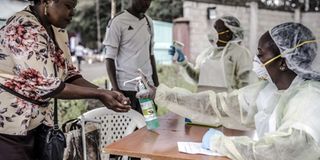Kenya can flatten Covid-19 curve and this is how

Health workers attend to visitors at Mbagathi Hospital. The government had announced a projection of 10,000 Covid cases by the end of April . PHOTO | FILE | NATION MEDIA GROUP
Although the Covid-19 numbers continue to go up, Kenya has an opportunity to get ahead of the epidemic curve if policymakers learn from elsewhere, look at the needs and resources available and act decisively.
After a hesitant start, there have been laudable responses by the government, in contrast to other parts of the world. But, in trying to avert a crisis, governments have to seek their citizens’ consent and ensure their compliance.
They need to ensure there is transparent and accurate information, with independent scrutiny and oversight, to build the public’s trust and effect greater positive impact together.
Assessments by the World Health Organization point to substantial limitations in capacity to respond to the pandemic in Africa. There are shortages of infrastructural capacity such as critical care beds, ventilators and laboratories as well as human resources for health. In the Kenyan context, therefore, the strategy has emphasise prevention.
This rests on two pillars: public health measures and socioeconomic support. Even though the government has embarked on a strategy to flatten the curve, this requires further clarity: what is the estimated scale of the epidemic in the country and hotspot counties, and what is needed in terms of additional health service capacity and socioeconomic support? What of any estimates of the collateral damage caused by the mitigation measures and the plans for an exit strategy? And is independent multidisciplinary expertise in place to advise on this?
The government had announced a projection of 10,000 Covid-19 cases by the end of April based on epidemiological modelling. While it is welcome to have a model informing the strategy, the details - type and content - of this model are not readily available nor are its underlying assumptions.
At this time 5,000 cases were expected, yet the official tally shows a much smaller number. Is this consistent with the modelling or due to a large caseload in the community with a low reporting rate or other reasons?
The identification of the virus spread, its risk factors, admissions to facilities, co-morbidities, prevention behaviour and disease outcomes across the country will assist in the understanding of the epidemic and inform locally-relevant control measures. A regular, timely mandatory reporting dataset for all health services, including the private sector, is relevant here. Similarly, it is important to know how well the population is adhering to the mitigation measures in place especially in particular groups such as the transport sector. Cultural beliefs and behaviour of the population will contribute greatly to adherence to mitigation measures, risk exposure and spread.
So, fact-based public communication and health literacy – the ability of people to obtain and understand health issues – of the population is important. Testing strategies need to be identified for community facilities and home settings, possibly using community health workers. Linked to the health response is the socio-economic one. To keep the population adherent requires an adequate safety net and protected supply chains. Kenya’s deadliest days lie ahead. Future prevention options will need credible information and considered judgement or else risk subsequent waves of infection, and preventable additional adverse health and socio- economic impacts. The population is a partner in this.
Dr Mohiddin, Dr Shah and Prof Luchters of Aga Khan University


